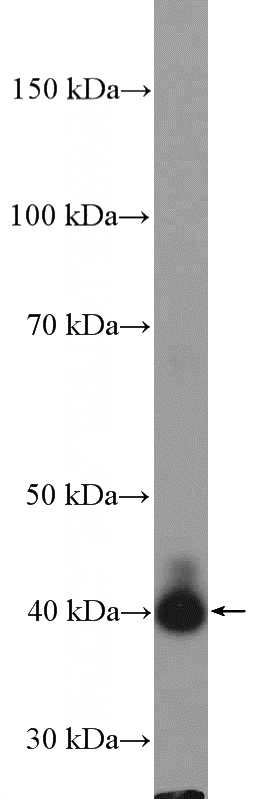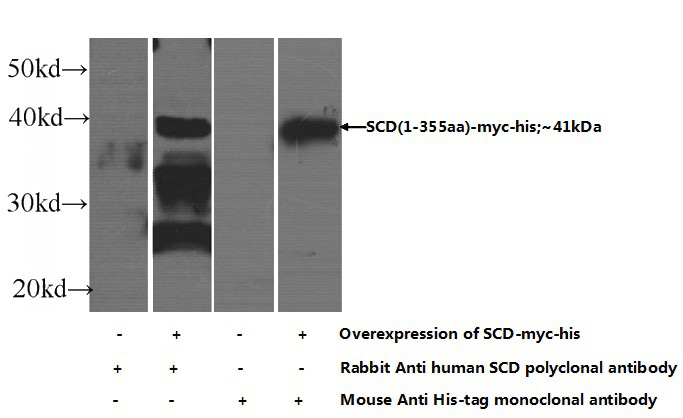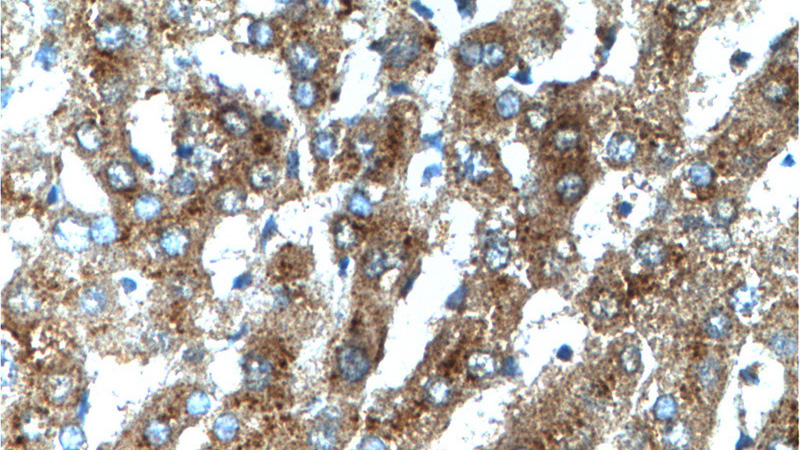-
Product Name
SCD antibody
- Documents
-
Description
SCD Rabbit Polyclonal antibody. Positive WB detected in rat liver tissue, HEK-293 cells. Positive IHC detected in human liver tissue, human brain tissue. Observed molecular weight by Western-blot: 40 kDa
-
Tested applications
ELISA, IHC, WB
-
Species reactivity
Human, Rat; other species not tested.
-
Alternative names
Acyl CoA desaturase antibody; Delta(9) desaturase antibody; FADS5 antibody; Fatty acid desaturase antibody; MSTP008 antibody; SCD antibody; SCD1 antibody; SCDOS antibody; Stearoyl CoA desaturase antibody
-
Isotype
Rabbit IgG
-
Preparation
This antibody was obtained by immunization of SCD recombinant protein (Accession Number: BC005807). Purification method: Antigen affinity purified.
-
Clonality
Polyclonal
-
Formulation
PBS with 0.02% sodium azide and 50% glycerol pH 7.3.
-
Storage instructions
Store at -20℃. DO NOT ALIQUOT
-
Applications
Recommended Dilution:
WB: 1:200-1:1000
IHC: 1:20-1:200
-
Validations

rat liver tissue were subjected to SDS PAGE followed by western blot with Catalog No:114989(SCD Antibody) at dilution of 1:300

HEK-293 cells were subjected to SDS PAGE followed by western blot with Catalog No:114989(SCD Antibody) at dilution of 1:1000

Immunohistochemistry of paraffin-embedded human liver tissue slide using Catalog No:114989(SCD Antibody) at dilution of 1:200 (under 40x lens).
-
Background
SCD (stearoyl-CoA desaturase) is a 37-45 kDa (PMID:10946019) microsomal fatty acid monodesaturase, also commonly known as 9-desaturase, which catalyses the committed step in the biosynthesis of mono-unsaturated fatty acids from saturated fatty acids. Five SCD genes (SCD1, SCD2, SCD3,SCD4 and SCD5) have been identified and characterized in mice and SCD1 and SCD2 are the main isoforms expressed in mouse liver and brain respectively, SCD3 is expressed exclusively in skin, whereas SCD4 is expressed predominantly in the heart. SCD1and SCD5 has been the only human SCD gene identified and characterized todate(PMID:15907797 ). The formation of homodimers and oligomers is an intrinsic property of SCD proteins, which may play an important role in regulating the half-life of the SCDenzymes, thus representing a novel regulatory mechanism for SCD enzymes, in addition to the transcriptional and post-translational regulations. A 32-kDa SCD1 degradation product identified may be caused by a major cleavage site at the C-terminus, thus representing a novel degradation product(PMID:15610069).
Related Products / Services
Please note: All products are "FOR RESEARCH USE ONLY AND ARE NOT INTENDED FOR DIAGNOSTIC OR THERAPEUTIC USE"
